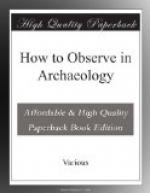The late tombs round Jerusalem are in the form of caves driven horizontally into the hill-sides. Further south, e.g. in the region round Beit Jibrin, they are more frequently sunk vertically, the entrance being in the roof of the burial chamber, or approached by a square shaft (a reversion to the Second Semitic form, except that these latter have round shafts).
IV. Caves.
The history of the artificial caves hewn in the soft
limestone of
Palestine, is quite unknown. The caves of the
neighbourhood of Beit
Jibrin provide ample material for several months’
exploration.
Though the caves are labyrinthine there is little fear of an explorer losing his way: he should, however, be well provided with lights, as it would be extremely awkward to be left in the innermost recess of a cave consisting of ten or a dozen chambers united by narrow creep-passages, without adequate illumination. There are occasionally unexpected and dangerous pitfalls: and hyenas and serpents often shelter in the caves. The present writer has explored many of them entirely alone, but this is, on the whole, not to be recommended.
Besides planning the cave, its walls should be searched for inscriptions, &c. It should be remembered, however, that these may have been added at any time and do not necessarily belong to the original excavation. Symbols, apparently of a phallic nature, are sometimes cut on the walls, as well as crosses and other Christian devices, and Cufic inscriptions. Frequently the walls are pitted with the loculi of a columbarium, which, however, appear to be too small to receive cinerary urns and must be intended for some other purpose.
V. Pottery.
Owing to the importance of the subject a special section on Pottery is given here, and the two accompanying plates (XII) show some of the commonest types of vessels. But the student cannot learn all he will need to know of Palestinian pottery from a few pages of print. A representative series of specimens will be found in the Jerusalem Museum: he may supplement his study of these by the perusal of reports on excavations, such as Petrie, Tell el-Hesy (pp. 40-50); Bliss, A Mound of Many Cities (passim); Excavations in Palestine (pp. 71-141); Macalister, Excavation of Gezer (vol. ii, pp. 128-239; and plates); Sellin, Jericho; Schumacher, Tell et-Mutasellim.




